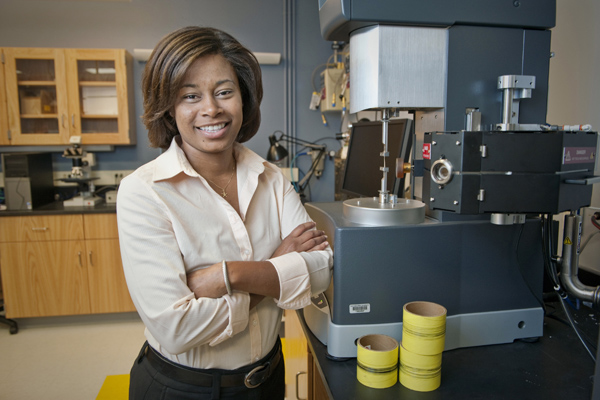From stronger Kevlar to better biology

Place two large, sturdy logs in a streambed, and they will help guide the water in a particular direction. But imagine if the water started mimicking the rigidity of the logs in addition to flowing along them. That’s essentially what happens in a directed assembly method developed by Marilyn Minus, an assistant professor in Northeastern’s Department of Mechanical and Industrial Engineering.
Instead of logs, Minus uses tiny carbon nanotubes and her “water” can be just about any kind of polymer solution. So far, she’s used the approach to develop a polymer composite material that is stronger than Kevlar yet much less expensive and lighter weight. In that case, the polymer not only follows the direction of the nanotube logs but also mimics their uniquely strong properties.
With funding from a new CAREER award from the National Science Foundation, Minus is now expanding this work to incorporate more polymer classes: flame retardant materials and biological molecules.
“With the flame retardants, we want the high-temperature polymer and nanotube to interact, not necessarily act like the nanotubes,” Minus said. Essentially, she wants the two materials to “communicate” by passing heat between one another, thereby increasing the temperature threshold of the flame retardants and allowing them to last even longer. “The nanomaterial can grab that heat and conduct it away, and it basically saves that polymer from burning up too quickly,” she explained. “The polymer we’re using can already withstand quite high temperatures; we’re just pushing it even further.”
In the case of collagen—the first biological molecule to which Minus has applied her method—Minus hopes the approach will allow the nanotubes to lend their rigidity to the system. Inside the body, collagen molecules organize themselves into a complex matrix that supports the structure of every one of our cells. But outside the body, researchers have had major challenges trying to reliably recreate this matrix.
If scientists could make collagen work outside the body the same way it does inside, it could provide an invaluable platform for testing drugs, understanding how tissues work, and even shedding light on the origins of a variety of diseases, Minus said.
Based on her prior research, she has found that the key to success in taking this approach is matching the size and geometry of the carbon nanoparticles she uses with that of the polymer in question. For instance, collagen molecules are about 300 nanometers long and 1.5 nanometers in diameter, so she’ll want to find a nanotube that roughly meets those dimensions. She’ll also want to use nanotubes for this application rather than the other carbon forms she has at her disposal: graphene, graphite, fullerenes, or even small nanocarbon particles—each of which offers a unique structure.
“We’re trying to change the entropy of the system in order to get the polymers to organize themselves around the nanomaterials,” Minus said. “Then you should be able to get this effect.”




